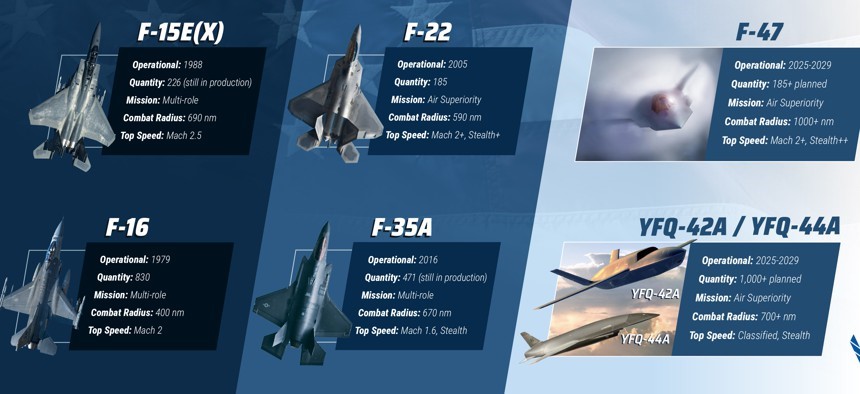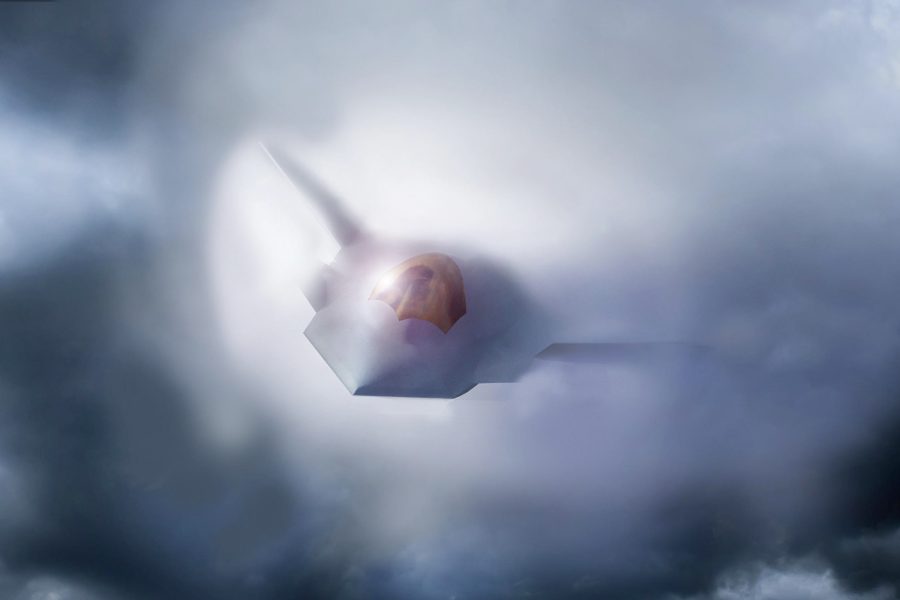The F-47 Next-Generation Air Dominance fighter will have a combat radius of greater than 1,000 miles—nearly double that of the F-22—and the Air Force plans to acquire more than 185 of them, Chief of Staff Gen. David W. Allvin revealed May 13 in a post on the social media site X.
The first Collaborative Combat Aircraft, so-called Increment 1, will have a combat radius of more than 700 miles, which is greater than that of the F-22 or F-35, the service revealed. The Air Force plans to acquire more than 1,000 of them. The Air Force also suggested that it will take longer for the two CCAs to make their first flights than expected.
“Our [Air Force] will continue to be the world’s best example of speed, agility, and lethality,” Allvin wrote in the post. “Modernization means fielding a collection of assets that provide unique dilemmas for adversaries—matching capabilities to threats—while keeping us on the right side of the cost curve.”
The revelations came in a graphic accompanying Allvin’s post. It shows the F-15E/EX, F-16, F-22, F-35, F-47, and the two CCAs—the YFQ-42A and YFQ-44A. Each is labeled with the date of their entry into operational service, combat radius, speed, and a very basic description of their stealth capabilities.
The graphic confirmed speculation that the NGAD would have to have far greater range and stealth than the F-22, to fulfill the Air Force’s desire to be a stand-in force at transoceanic ranges. Yet, at a “combat radius” of 1,000+ miles, an F-47 launching from Guam would not be able to reach the mainland of China on internal fuel, or even Taiwan, some 1,700 miles away, and safely return to base. Aerial refueling would be necessary to extend its reach, although fewer tankings would be needed for such a mission.

Unclear is how much “+” sign in the graphic adds to the stated figure. The given numbers are likely to be less than what the aircraft are actually capable of in order to keep adversaries guessing about their real performance.
The range given for the F-47 would seem to exceed that of the Navy’s counterpart of the NGAD, the F/A-XX. Rear Adm. Michael Donnely, the Navy’s Director of Air Warfare, said at a recent Navy League convention that the F/A-XX would have 25 percent more range than the F-35C or F/A-18E/F.
With a combat radius of 700 nautical miles, the CCAs would be able to fly out ahead of the F-22 and F-35.
While former Air Force Secretary Frank Kendall said at AFA’s 2023 Air Warfare Symposium that 200 F-47s was the acquisition target, the graphic mentioned “185+”, revealing that the Air Force now plans the F-47 to be a virtual one-for-one replacement for the F-22, of which there are also 185. The reduction may have something to do with the F-47’s extremely high cost of an estimated $300 million per copy; so high that Kendall had planned to delete the NGAD from the fiscal 2026 budget request in favor of other priorities.
Both the F-47 and the CCAs were labeled as planned to enter service between 2025 and 2029, although the latter part of that timeframe is more consistent with previous service comments. The F-47 was also labeled as being a “Mach 2+” fighter; less than the F-15, which was labeled a Mach 2.5 aircraft, and consistent with the F-22’s top speed, also labeled as Mach 2+.
The graphic offered a rudimentary assessment of each aircraft’s observability. While the F-35 was described as a “stealth” aircraft, as were the CCAs, the F-22 was described as a “Stealth +” type while the F-47 was described as “Stealth ++,” consistent with service comments that it would have to be substantially stealthier than the F-22 to survive anticipated adversary air defenses.
The F-22’s combat radius was described as 590 nautical miles, higher than typical descriptions, which peg that number at around 470 miles. Combat radius, however, is a fungible figure, and depends largely on the profile flown to get to the target, and whether the aircraft is expected to perform aggressive combat maneuvers along the way. The Air Force’s official F-22 fact sheet doesn’t provide a combat radius, but the figure in Allvin’s graphic suggests a range augmented by external fuel tanks.
To be “stealth ++” though, it’s likely that the F-47’s range does not count any external fuel tanks, which would increase its radar signature.
The graphic also confirmed that the two CCAs have a primary mission of “air superiority,” meaning they will largely serve as missile carriers for the fifth-generation crewed fighters they will escort into battle, expanding the number of shots each crewed fighter can take per sortie.
The Air Force declined to say whether the “operational” descriptor on the F-47 and CCAs meant that those types will declare Initial Operational Capability in those timeframes. An Air Force official would say only that the F-47 “will fly during this administration,” a comment the service has made before, and which indicates the F-47’s first flight will happen before January 2029. A declaration of IOC requires a certain number of production-representative assets, but a USAF spokesperson declined to say how many F-47s or CCAs will constitute IOC, or when the service plans to declare that status.
The Air Force and its CCA contractors Anduril Industries and General Atomics Aeronautical Systems, have been promoting speed in the CCA program, and have said the two aircraft will fly “this summer.” However, the Air Force said in response to a query that Anduril and General Atomics “will fly their production-representative test aircraft by the end of the calendar year,” indicating a possible delay of three to five months.
It’s not clear if the inventory objective of 1,000 CCAs in the graphic refers to the Increment 1 aircraft now in ground test, or CCAs of all increments. The Air Force has said it will launch Increment 2 next year, and service leaders have suggested that it could be less sophisticated and less costly aircraft than Increment 1. Senior Air Force officials have referred to future iterations known as Increment 3 and 4 without providing further details.
The Air Force declined to say what prompted Allvin to make the revelations, but a service official said the release of the graphic was an Air Force initiative and not made in response to a Capitol Hill or White House request.


